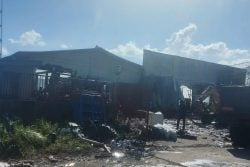DHAKA (Reuters) – Two factory bosses and two engineers were detained in Bangladesh on Saturday, three days after the collapse of a building where low-cost garments were made for Western brands killed at least 352 people.
More were being pulled alive from the rubble at the building, where police said as many as 900 people were still missing in Bangladesh’s worst ever industrial accident.
The owner of the eight-storey building that fell like a pack of cards around more than 3,000 mainly young women workers was still on the run.
Police said several of his relatives were detained to compel him to hand himself in, and an alert had gone out to airport and border authorities to prevent him from fleeing the country.
Officials said Rana Plaza, on the outskirts of the capital, Dhaka, had been built on spongy ground without the correct permits, and the workers were sent in on Wednesday despite warnings the previous day that it was structurally unsafe.
Anger at the negligence has sparked days of protests and clashes, with police on Saturday using tear gas, water cannons and rubber bullets to quell demonstrators who burned cars.
Two engineers involved in building the complex were picked up at their homes early on Saturday, Dhaka district police chief Habibur Rahman said. He said they were arrested for dismissing a warning not to open the building after a jolt was felt and cracks were noticed on some pillars the previous day.
The owner and managing director of the largest of the five factories in the complex, New Wave Style, surrendered to the country’s garment industry association during the night and they were handed over to police. They will be kept in remand for an initial 12 days.
The factory, which listed many European and North American retailers as its customers, occupied upper floors of the building that officials said had been added illegally.
“Everyone involved – including the designer, engineer, and builders – will be arrested for putting up this defective building,” said junior internal affairs minister Shamsul Huq.
Anger over the working conditions of Bangladesh’s 3.6 million garment workers – most of whom are women earning as little as $38 a month – has grown since the disaster.
Hundreds were on the streets again on Saturday, smashing and burning cars and sparking more battles with police, who responded with tear gas, rubber bullets and a water cannon. Eyewitnesses said dozens of people were injured in the clashes.
An alliance of leftist parties which is part of the ruling coalition said it would call a national strike on May 2 if all those responsible for the disaster were not arrested by Sunday.
Rahman identified the owner of the building as Mohammed Sohel Rana, a leader of the ruling Awami League’s youth front.
“People are asking for his head, which is quite natural,” said H.T. Imam, an adviser to the prime minister.
Wednesday’s collapse was the third major industrial incident in five months in Bangladesh, the second-largest exporter of garments in the world. In November, a fire at the Tazreen Fashion factory nearby the latest disaster killed 112 people.
Such incidents have raised serious questions about worker safety and low wages, and could taint the reputation of the poor South Asian country, which relies on garments for 80 percent of its exports.
The Bangladesh Garment Manufacturers and Exporters Association (BGMEA) on Saturday asked garment factory owners to produce building designs by July in a bid to improve safety.
Remarkably, rescuers armed with rod cutters and drills were still pulling people alive from the precarious mound of rubble – 29 in all since dawn on Saturday.
Marina Begum, 22, spoke from a hospital bed of her ordeal inside the broken building for three days.
“It felt like I was in hell,” she told reporters. “It was so hot, I could hardly breathe, there was no food and water. When I regained my senses I found myself in this hospital bed.”
Frantic efforts were under way to save 15 people trapped under the concrete who were being supplied with dried food, bottled water and oxygen.
Heavy machinery will not be used to remove the remaining bodies and debris until all the survivors are rescued, junior minister for local government Jahangir Kabir Nanak said.
About 2,500 people have been rescued from the remains of the building in the commercial suburb of Savar, about 30 km (20 miles) from Dhaka.
Emdadul Islam, chief engineer of the state-run Capital Development Authority (CDA), said the owner of the building had not received the proper building consent, obtaining a permit for a five-storey building from the local municipality which did not have the authority to grant it.
“Only CDA can give such approval,” he said. “We are trying to get the original design from the municipality, but since the concerned official is in hiding we cannot get it readily.”
Furthermore, another three storeys had been added illegally, he said. “Savar is not an industrial zone, and for that reason no factory can be housed in Rana Plaza,” Islam told Reuters.
Islam said the building had been erected on the site of a pond filled in with sand and earth, weakening the foundations.
Duty free access offered by Western countries and low wages helped turn Bangladesh’s garment exports into a $19 billion a year industry. Sixty percent of the clothes go to Europe. The United States takes 23 percent and Canada takes 5 percent.
North American and European chains, including British retailer Primark and Canada’s Loblaw, a unit of George Weston Ltd, said they were supplied by factories in the Rana Plaza building.
Loblaw, which had a small number of “Joe Fresh” apparel items made at one of the factories, said on Saturday that it was working with other retailers to provide aid and support.
It said it was sending representatives to Bangladesh and was also joining what it described as an urgent meeting with other retailers and the Retail Council of Canada.





